|
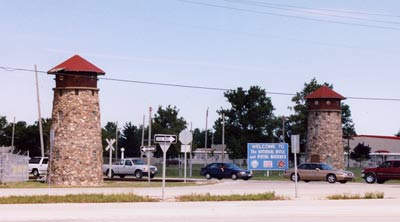
|
|
Camp Perry on Lake Erie near Port Clinton
|
The sun has just peeked over the horizon at our backs on this
steamy August morning. We’ll all lose a few pounds before this
day is over. My sweaty hands grip the wooden stock of the rifle
as I check the sights. All around me others are in similar
stages of preparation, some putting in earplugs. They’ve been
here before and know the damage to sensitive ears when hundreds
of rifles begin firing. Even though there are almost two
thousand souls settled on this tiny peninsula, it’s strangely
quiet, hardly a sound. The pre-dawn breakfast of powdered eggs,
“SOS,” and syrupy coffee is lying heavy in my stomach which
grumbles in protest. The guy next to me looks over and chuckles.
No doubt he’s a veteran. I’m a rookie and my main concern is
that I don’t mess up.
At least it’s not combat. It’s Camp Perry on Lake Erie in Ohio and we’ve all gathered for the John C. Garand Rifle Tournament, part of the Civilian Marksmanship Program’s National Annual Meet. Our tournament has drawn over 1500 participants, everyone firing rifles used during World War II and Korea. Contestants come in all ages, genders, and choice of wardrobe with some sporting original and complete World War II combat gear, including ammo belts, leather boots, field pack, steel helmet, the whole works. They must be terribly uncomfortable with all that wool and heavy cotton in this heat. Such a price paid for historical accuracy.
The Civilian Marksmanship Program was created by a pre-presidential Teddy Roosevelt, recently returned from the Spanish-American war and Rough Rider fame. He spoke at length about the “decidedly pathetic” marksmanship of American troops during the campaign and spearheaded a national movement to provide funding to the various state militias to develop marksmanship instruction ranges and camps to go with them. Camp Perry was the result in 1903 when the Ohio Legislature authorized the purchase of 300 acres on the south shore of Lake Erie near Port Clinton.
The John C. Garand Match is named for the inventor of the M1 rifle, the main issue weapon for US soldiers in World War II. Ironically, Garand was a Canadian who worked for the US Government when word came down that the army was looking for a new primary rifle that could fire automatically to replace the aging bolt-action Springfield rifle. Garand’s prototype far outshone the competition, so was adopted just before World War II.
“I just love these old Garands,” says my chuckling neighbor on the Ready Line. He is a Korean War veteran from Texas as part of his infantry unit’s annual reunion. “I only do this once a year,” he laughs. “But I really look forward to it. I get to see the old guys and meet a great bunch of new people.” Even though scores are by individual only, friends and families enjoy forming informal teams, often using this national match as the site for annual reunions.
|
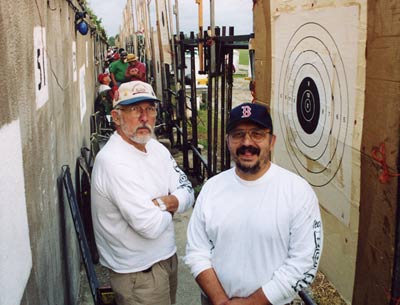
|
|
John and Rob Bogue
|
I am the newest member of “Team Bogue” comprised primarily of members of the Bogue family, one of whom, Rob, I have known since college days decades ago and as a fellow educator. Rob’s oldest brother, John, a retired U.S. Army colonel, is able to outfit the entire team with weaponry because one of his interests is collecting the various makes of the World War II rifles and carbines. He and next-youngest brother Marty, a Toledo high school history teacher, spent a lot of their time and money collecting old military memorabilia such as weapons, medals, and gear, even a Jeep. It was John and Marty who formed “Team Bogue” to compete each year since the CMP developed the Garand Tournament. Many of my teammates are John’s children and their spouses gathering each year from all over the country during this one long weekend in August.
Then, sadly, just a few months before the tournament, Marty died suddenly just as he was preparing to retire from teaching. Even though the yearly event would not be the same without one of the team’s captains, the family vowed to continue the tournament tradition. I was honored when they asked me to take Marty’s place on the team, though my use of high powered weapons was limited to my old .30-30 Winchester on my grandparents’ farm when I was much younger. John’s reply was, “It’s just for fun. We don’t take it seriously.”
|
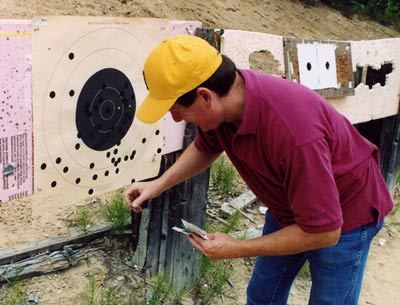
|
|
Marking Practice Target
|
I showed up a couple of days before the tournament so Rob and John could check me out on the use of the M1 at a local firing range. John said I could have my choice of using an M1 Garand or the carbine version. I decided to try out the Garand rifle first.
John showed me some of the idiosyncrasies of the weapon, including the unusual loading steps. The Garand fires an 8-cartridge clip, loaded from the top, then expels the clip after the last shot is fired, leaving the breech open to accept another clip. There is a heavy spring action that the shooter has to be careful of when loading the new magazine. If not done correctly, the breech can suddenly close while pushing the magazine down into the chamber with a force that can easily bruise the user’s thumb tip. According to John, quite a few soldiers came home from combat with “Garand Thumb” scars.
I enjoyed firing the Garand, though at over 10 pounds, it is quite the beast to hold steady, especially at the standing position. I can’t imagine those kids carrying Garands, plus their full load of gear, up Omaha Beach or slogging through the jungles of Guadalcanal. I was pretty accurate with it, but that “Garand Thumb” stuff was a bit intimidating, along with the weight factor. So John suggested I try out the carbine.
|

|
|
M1 and Carbine
|
Rob shoots a carbine and likes it very much, though, having a much shorter barrel and less powerful cartridge (though still .30 caliber) it is harder to score well with the “pop gun,” especially on windy days. “It’s a lot lighter and easier to load,” Rob explained as he turned the carbine over and inserted the ten-shot magazine through the bottom. My accuracy wasn’t as consistent from the various firing positions as it was with the Garand, but I was more comfortable with it. I told John that I would try using the carbine this year. He went to his car and pulled out about five more cased carbines, suggesting I try different ones to see which works for me the best. Aren’t they all the same, I asked?
John explained that the US military used “outsourcing” with many different companies to build weapons during the war. While Springfield Arms made many of the M1 Garands and Winchester a lot of the carbines, other companies (including Underwood of typewriter fame and Rock-Ola who made juke boxes during peacetime, to name just a few) also contracted to build the weapons to U.S. military specs, so parts would interchange easily.
After firing several different carbines, I finally settled on a Chicago-built Rock-Ola model that seemed to work well. “Great. That’s all yours,” John said. We then looked at the tag and realized for the first time that this carbine was the one that Marty had used the previous years. I protested that this weapon should likely be “retired” and I offered to select a different one, but John insisted that I use it. We spent another hour or so “sighting in” our rifles and I got very comfortable shooting the carbine at the three positions: standing, kneeling and prone.
Looking at the 200-yard target we’d be shooting at, it was much larger (good thing!) than the little .22 targets I’d shot at as a kid. They are very typical targets with the alternating black and white bands surrounding the black “bullseye.” A shot in the center black area is worth 10 points. The next black area, before the white begins, is worth 9 points and on down the line until the last actual circled ring is worth five points. At the tournament, each contestant shoots 30 rounds, 10 each during three segments: slow fire, prone, and rapid fire. A “perfect” score is 300, just like in bowling. And just as in bowling, a perfect score is quite a rare accomplishment.
Because I was designated as a “new shooter” I was required to attend a safety clinic the evening before the match. It was very informal and informative, taught by Mr. Dick Whiting, one of the original coordinators of the Garand Match. With the help of several assistants, he went through the correct loading procedures, basic weapons handling safety issues, and scoring. I learned that each contestant was required to “serve his or her time in the pits” scoring shooters’ hits and marking targets. He explained how easy it was to place the location plugs after each shot and then score each shooter’s total. I’d figured all I’d have to do was to show up, shoot, then go eat barbeque at John’s lakeside cottage. This sounded like real work in those pits. More pressure.
Our squading assignment put us at the firing range at 6:15 a.m. John suggested we all meet at the mess hall about 5:30 a.m. (people EAT this early?). “He just loves this,” Rob confided as we returned to the SUV. “He really likes having his whole family there together for mess.” Okay, I thought, I can do this.
|
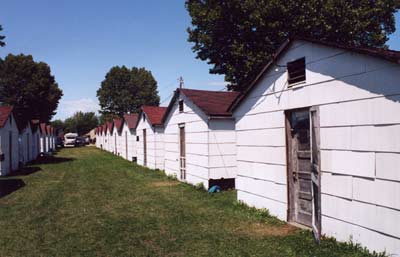
|
|
POW Huts
|
So after a restless night in a POW hut, a quick cold shower in the latrine and hurrying through the mess line, plus the walk to the firing range and “drawing ammo” (they give each contestant enough ammunition for the 30 shots, plus more for “sighting in”), it looks like things are getting serious. Contestants are silently unloading their gear in the pre-dawn gloom, some with beautifully restored weapons.
The activity is interrupted momentarily as a cannon fires to the southeast and we hear a recording of “The Star Spangled Banner” and watch the colors being raised about a quarter mile away on the next firing range. It brings back memories of high school and college sporting events in which I participated.
|
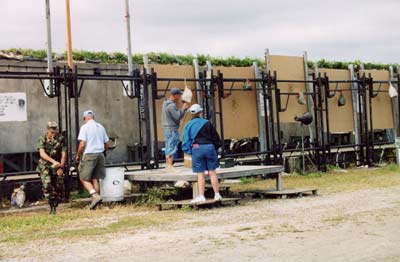
|
|
In the Pits
|
Rob and I have been squaded together (thank goodness – if I make a dumb mistake, at least Rob won’t razz me too badly). We are assigned the “pits” first, so we walk the several hundred yards to the target line and locate the corresponding target rack at which we’ll later be shooting – in our case, Target 51.
Have you ever seen the Gary Cooper film Sergeant York? Well, they could have filmed the basic training rifle shooting scenes of that movie at Camp Perry. Maybe they did. These target pits are the spitting image of the ones depicted in that film, right down to the metal slides and wooden frames onto which we paste the massive targets. After each shot, we lower the target on the slide, push a rubber orange plug into the hole (if the shooter “hits paper”) and slide it back up again for the next shot. Of course, during the “rapid fire” segment, we wait until all ten shots were completed!
We are supervised by members of the Ohio National Guard, some of whom are quite talkative and friendly while others clearly resent having to baby-sit us “tenderfeet.” At least that’s the way I interpret their stares at that early morning hour.
“Targets Up!” comes the command over the PA system, followed by “Ready on the right. Ready on the left. Ready on the firing line.” Then, a few seconds later: “Fire at will!” and the commotion begins. It sounds like hundreds of Black Cat firecrackers going off on the Fourth of July. Rob and I lean against the cement bulkhead, our eyes on the target. Our shooting counterpart be taking his time because it is several seconds before we hear the “slap” and see the tear in the paper he scores a hit in the second black ring. We dutifully pull down the target, place an orange plug in the hole, note his score in the margin, then run the target back up. It takes two working as a team to do this efficiently and not hold up the process.
I really enjoy this part of the tournament, for the first hour or so. But as the sun gets higher in the sky I have to take off my sweatshirt. After all, even though we are near the lake, it is early August in Ohio – hot and humid.
Finally, all the shooters in the other squads finish and our “pit time” is done. I head for the port-a-potty to relieve myself of some of that breakfast coffee. I barely have enough time before the range boss announces on the public address system that we should be at the Ready Line preparing to go to the Firing Line.
|
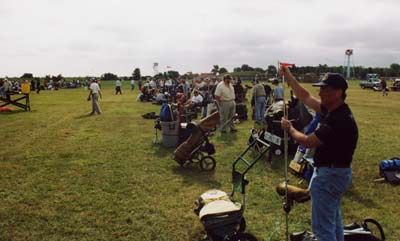
|
|
Ready Line
|
I am amazed at the amount of fancy gear some of the other contestants bring to the Firing Line: expensive spotting scopes with elaborate tri-pod-scoring table combos, shooting jackets complete with leather straps and nylon cartridge holders, thick “prone pads” some of them with the logo of a gun or ammo manufacturer emblazoned on the sides. Rob and I have part of a sleeping mat on which to rest our elbows and my old hiking binoculars. That and our ear protection comprise the sum total of our “shooting gear.” Rob will shoot first while I spot his hits.
“The pits are now closed,” announces from the range officer from his tower. “Ready on the right. Ready on the left. Ready on the firing line.” There is a lull as everyone waits, then, “Practice round. Fire at will.” This time, of course, the firecracker sound is much louder, like M80s going off all around us. Rob starts firing his carbine after taking an extra long time aiming. I take out my little binoculars and advise Rob he is hitting the target low and to the right, but close to the rings. He adjusts his aim. To our left, John is practice firing his Garand. Down the line I can see the rest of Team Bogue – their distinctive shirts with large, green bulls-eyes on the back.
“I just want to do better than last year,” Rob mutters as he stands up for the final segment. As he completes the last of his thirty shots, I quickly tally his score and it appears that he has easily doubled his previous year’s score. We wait while the pit crew on Target 51 totals up his “official” score and raises the target, this time with the skinny chalkboard hanging on the left side. Sure enough: a 178, much higher than last year.
|
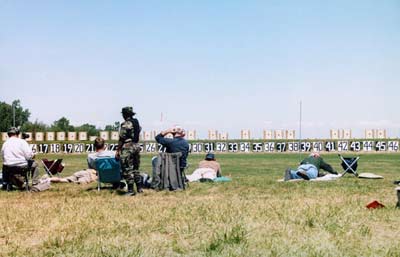
|
|
Firing Line
|
So it is finally my turn. Rob’s success has given me some confidence, though I am still a bit nervous as I walk to the firing line with Marty’s carbine and the clips of ammo. I get down on the ground, prone position first, push the mat under my elbows and squint at the target 200 yards away. It seems a lot further than the targets on yesterday’s practice range. A slight breeze has come up so Rob reminds me to pay particular attention to the first five practice shots to see if I’ll need to allow for the wind. It seems like an eternity waiting for them to announce the order to fire.
Finally: “Practice round! Ready on the right! Ready on the left! Ready on the firing line! Fire at will!”
My first two practice shots are so far off the paper that Rob can’t even see them. By the third shot I’ve moved to the right side of the circles, though still a bit low. My fourth practice shot is centered, but way high. Rob yells at me through the noise (and my ear muffs) that the wind is affecting my shots, so to just wait for a calm before firing. My last practice shot is low and to the right, just like yesterday, so at least I know that if I compensate like yesterday, it should be okay. I wait while the firing around me withers to a halt. The sudden silence adds to my nervousness. Rob gives me an encouraging “thumbs up.”
“Ready on the left! Ready on the right! Ready on the firing line! Fire at will!” the disembodied voice announce. This was for real. Marty’s M1 is going to compete! I take my time, wait for the breeze to calm, pull in a deep breath, let half of it out and fire.
My first few shots are high and to the right, just barely on the paper, so I compensate and tell myself to slow down. After all, I have fifteen minutes to get off these first ten shots. My hits drift more toward the center, but only as far as the 7- and 8-point rings. I’m done with my ten initial shots long before most of the other shooters, so I just stay on the ground, listening to the firing. I tell myself that I’ll shoot better during the rapid-fire segment.
And I do. Even though my first two shots miss altogether, once I change clips (a mandatory maneuver), my grouping becomes much better and well into the black with two bulls-eyes! In fact, it looks like my breaking a hundred is just about in the bag. Geez. I hadn’t expected to get a “good” score. The slow fire from standing position is the last segment and I have ten minutes to get off ten shots. At one shot per minute, I can surely zone in on the target. Wow! Maybe even equal Rob’s score.
“Man plans; God laughs.” An old saying, but sometimes so appropriate. It’s like the old hubris/nemesis law of Greek mythology wherein a person who gets too cocky and tempts the wrath of the gods ultimately gets tossed down the temple stairs. As the final round begins, my first two shots are in the 7-point portion of the black area, and I’m moving slowly toward the center. I have the range. My confidence is soaring – unfortunately, like Icarus.
On my fifth shot, there is a subtle “click” as I pull the carbine’s trigger. Just a click with no recoil or noise. Why didn’t the carbine fire? Then I realize that the automatic bolt isn’t closed all the way. It’s open just a quarter of an inch. Is there a spent round in there that didn’t eject, or is the new round not seated completely in the chamber? I try to recall if, after the last shot, the round ejected. I can’t remember.
|
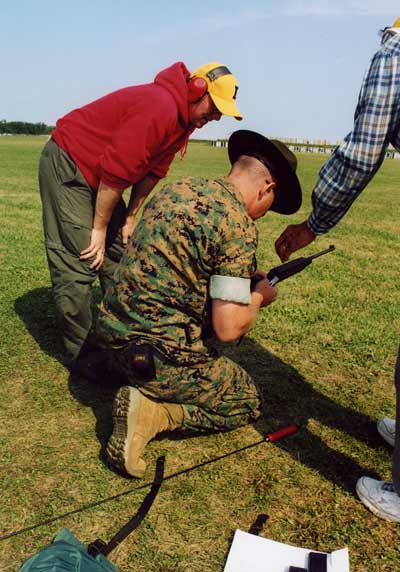
|
|
Jammed Carbine
|
I pull the bolt handle, trying to free it up, at least far enough back to see if there’s a live round or spent one in there. It won’t budge. Rob can see I’m having trouble and raises his hand to summon a range official to come take a look. A tall young sergeant wearing sunglasses hurries over. I explain the situation and he gives me that “Geez, another rookie” look as I hand him the carbine. He tries, as I had, to pull the bolt open, but it won’t budge for him either. He looks at the mechanism and pushes a couple of other places, eventually removing the stock-to-barrel strap. “I don’t know anything about these old things,” he grumbles. Another shooter, obviously a vet who knows about the carbine, comes over and offers some advice to the sergeant. Time is running out and it’s possible that I’ve fired my last rounds at Target 51. I just want Marty’s rifle to be okay, wondering how much damage I’ve done to it and if it can be fixed. It’s in several large pieces now as the two men struggle with it.
Finally, with both the soldier and new helper working on the gun, the bolt springs back, ejecting a spent round. “Cease Firing! Cease Firing! The time has expired” says the range officer. The time for the match has run out. And since this is a “No alibi” match (no excuses, no do-overs, etc.) my day is done.
It is nearly noon as our group vacates the range passing the next group of participants taking our place. I’m carrying Marty’s M1 in my arms like pieces of firewood.
John walks over and I don’t know who was more disappointed: me since I’ve destroyed Marty’s carbine, or John, since he hates to see my first Garand tournament end so badly. As it turns out, I score a 118, well over my 100-point goal and John isn’t concerned in the least over Marty’s carbine. Rob makes me feel better by saying, “Yep, it figures. Old Marty got the last laugh after all.”
The members of Team Bogue, along with our cheering section, all gather back at John’s lake cottage for a wonderful outdoor feast. I am presented with the “Team Bogue New Shooter” Award (of which I was the only one so qualified this year) which is a beautiful framed poster of Camp Perry’s centennial celebration. Later, as I get into my car to head home, John shakes my hand and says, “Hey! Next year how about we shoot Springfields!”
Just wait until next year.
NEXT ARTICLE
|
